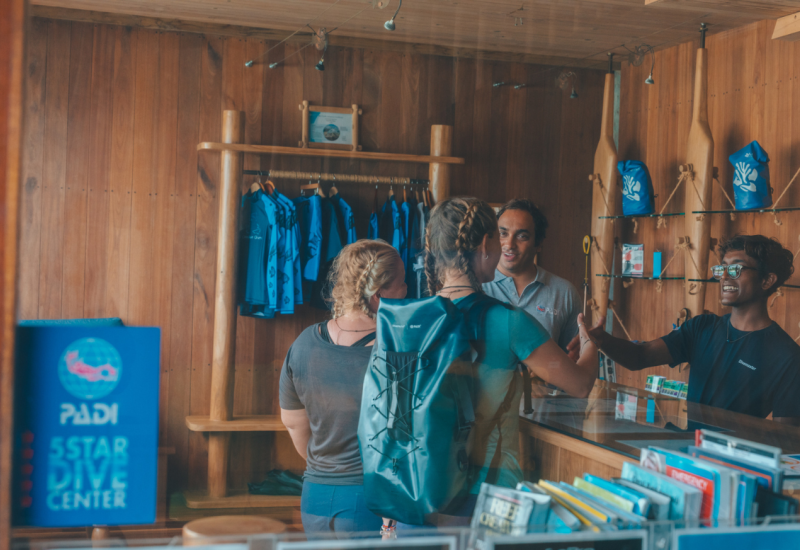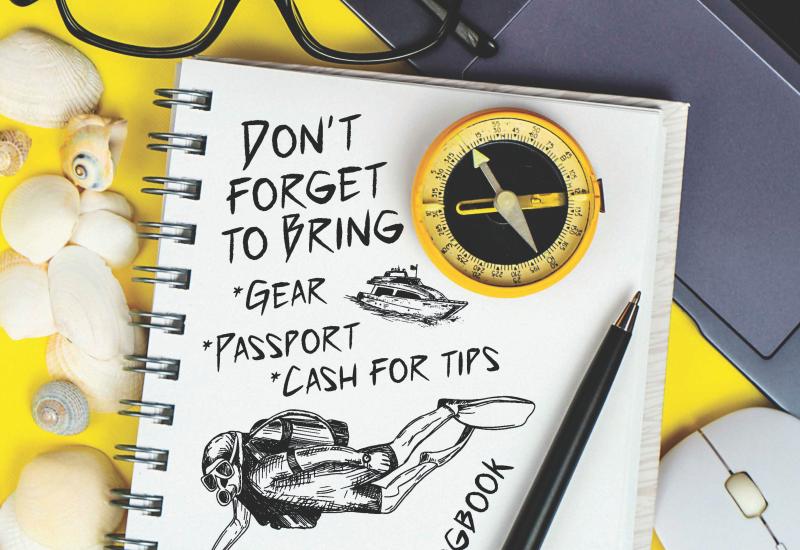Diving the Solomon Islands on the Bilikiki Liveaboard

Andrew SallmonSunlit swim-throughs
Where to begin? I’ve seen shipwrecks, gargantuan schools of fish, untouched reefs, and incredible creatures both large and small while exploring the Solomon Islands aboard M/V Bilikiki — but my favorite spot right now in this sprawling, exotic archipelago is a bunch of big holes in a rock.
Admittedly, it’s far more poetic to use the site name (Mbulo Caves) or even a basic description (swim-throughs along the edge of Mbulo Island). Semantics aside, the caves, swim-throughs, holes, whatever, aren’t really the point. That would be the rays of sun that pierce the overhanging foliage, dancing on the cavern walls and seafloor, filling the water with a laser show that imparts serenity better than any yoga studio. I sigh and let the world fade away, until all the other divers have explored and admired and departed. I know I must follow suit, so I reluctantly exit the grotto and begin my safety stop. I’m still blissed out, admiring the hard corals piled upon one another and the car-size sea fans jutting toward the open ocean, when something catches my eye: a pair of reef squid. Wait — make that a whole school!

Courtesy Bilikiki/Joanna O'SheaThe Bilikiki at anchor
They approach me cautiously, and I channel my inner sun rays as I photograph them, moving slowly so the squid will remain at ease. I’m aware that I’m drifting with the current, but I can hear the soft sound of a “tinnie” (one of Bilikiki’s dinghies) following nearby, and I know a member of the crew has his watchful eye on me. When I finally ascend, it’s to a placid surface, a delighted question from the tinnie driver (“Hey, how many squid were down there?”), and a relaxing ride back to the big boat where there’s a warm bowl of soup with my name on it.
Read More: Best Scuba Sites, Operators, Resorts and Liveaboards
I suppose I should provide some context here — Mbulo Island and its ludicrously gorgeous swim-throughs lie at the edge of Marovo Lagoon, a 270-square-mile saltwater behemoth in the western Solomons that encompasses some of the world’s most incredible dive sites. Of the divers lucky enough to be aboard Bilikiki, those who get to spend significant time in Marovo are exceptionally lucky. Mbulo Island is one of the lagoon’s crown jewels, as you’ve probably surmised, and our next dive site, Kicha Island, is another. We drop in on a corner to the push of current and the sight of soft corals, with mobula rays and fat gray reef sharks hunting on one side and jacks swirling on the other. I watch for a while, finally becoming distracted when I see another of the site’s famed residents: a large hawksbill turtle known for supermodel tendencies. Sure enough, he poses quite happily, leading me Pied Piper-style toward a bay filled with pink moon jellyfish.

Courtesy Bilikiki/Tom DemeyerThe 125-foot boat has 10 staterooms for divers.
Cruise directors Patricia Martinez and Fernando Miaguchi tell us that we’re in for even more of a treat in the coming days. Bilikiki’s experienced crew knows the Marovo area exceptionally well, and so our auspicious group will spend a few days exploring dive sites within the lagoon that few visitors ever get to see. Wrecks are a major feature here, with some, such as Japanese Maru No. 2 and the Seghe P-38 plane, imbued with World War II history, and others, like the vertically positioned Tuna Boat, simply an unfortunate story turned spectacular dive. The natural reefs are also magnificent here, with Wickham Island’s lush coral coverage, colorful anemones, and incredible macro life scoring the highest marks from all passengers.
No visit to this region — located in the South Pacific due east from Papua New Guinea — is complete without a shopping excursion, and our group excitedly clambers aboard the tinnies on our last afternoon in Marovo to visit a local carver’s market. The craftsmanship is astounding, and I run my hands over artwork that would fetch thousands of dollars back home — elaborately inlaid war masks, detailed carvings of sea creatures, even a few intricate tables. I shake my head in disbelief at Martinez, who’s purchasing armfuls of pineapples and mangoes for the boat. She winks at me and asks, “Need me to convert some currency for you?” I laugh and nod, pushing aside my baggage weight concerns to examine a fabulous bowl ornamented with glowing triangles of mother-of-pearl. If ever there were a place and time to splurge on extra cargo weight, it’s here and now.

Courtesy BilikikiThe boat's lounge area offers plenty of room to relax.
En route back from Marovo Lagoon, we stop for one last day at Mary Island, an uninhabited volcanic peak rimmed by fantastic sites such as Barracuda Point, a coral outcropping known for schooling fish. The current is kicking, and the fish are loving it; within minutes, I’m encompassed by a swirling school of jacks so dense that I nearly lose my buddy. After a while, the jacks shift to make way for a stream of chevron barracuda. We immerse ourselves in the ridiculous switch-off for an hour, finally letting the flow carry us into the shallows, where we spy blennies, octopuses and nudibranchs among the sponge-covered rocks.
At last, the sun dips low in the sky, and the captain pulls the anchor and starts motoring toward Honiara, capital of the Solomon Islands. A dolphin pod gathers to bid us farewell in the bow wake, and I lean far over the edge of the boat to watch. As the light glints into the water, the pod dives, following the rays down into the tranquil Solomon Sea.

Andrew SallmonSchools of jacks entertain divers in the Solomon Islands.

Allison Vitsky SallmonA blenny peeks out of its home.

Courtesy Bilikiki/Matt SmithCrinoids and sea fans decorate Marovo Lagoon.

Allison Vitsky SallmonThe Tuna Boat wreck.

Courtesy BilikikiCrew members supply seeds to local villages to ensure a regular supply of fresh produce.
5 Reasons to dive Bilikiki
1. Experience Rules: Bilikiki pioneered liveaboard diving in the Solomon Islands 30 years ago, and most crewmembers have been on board for over a decade — no one’s more familiar with the dive sites and conditions.
2. All-Access Pass: The ship’s longer itineraries (generally nine days or longer) often include stops at sites not commonly dived by other boats.
3. Locally Sourced: The Bilikiki crew distributes seeds to local villages to ensure a regular supply of fresh produce. The “Bilikiki market,” locals gathered in wooden canoes filled with fruits and veggies, is a common sight.
4. Fabulous Flexibility: At most sites, divers can opt to follow a guide or dive their own profile — often as long as their computers allow. No matter where you surface, skilled tinnie (dinghy) drivers will be waiting to whisk you back to the big boat.
5. Sensational Sundowners: The spacious sun deck on Bilikiki is a great place to soak up rays, but it’s an even better place to view the fiery South Pacific sunsets with delicious hors d’oeuvres.
Need to Know
When to Go: The Solomon Islands is located a few degrees from the equator and has little variation in air temperature (80 degrees F on average) throughout the year. The dry season runs from April through October, while the wet season spans from January through March. Bilikiki performs annual maintenance in January and February, avoiding the rainiest months.
Travelers Tip: All cruises start and end in Honiara, on Guadalcanal Island. Although the most direct flights from North America connect through Nadi, Fiji (a total travel time of 21 hours from Los Angeles is typical), itineraries that connect through Brisbane, Australia, offer more-frequent connecting flights to Honiara International Airport.
Dive Conditions: Water temperatures range from 80 to 86 degrees F, with the coolest temperatures in July through August; a 1 to 3 mm wetsuit is recommended. Visibility varies from approximately 35 to well over 100 feet, with nearshore lagoon sites generally having lower visibility than offshore sites. Currents are usually mild to moderate (with a few exceptions), though a surface marker buoy or personal locator beacon, such as a Nautilus LifeLine, is recommended due to the remote nature of this destination.
Operator: Bilikiki supports 20 passengers in 10 deluxe, air-conditioned staterooms with en suite bathrooms (eight cabins contain both a double bed plus a single bunk, and two cabins contain twin single beds). The steel-hull ship was constructed with South Pacific seas in mind and is exceptionally stable. Boasting a length of 125 feet and beam of 24 feet, a comfortable lounge, covered dining area, expansive sun deck, and separate camera-charging room, Bilikiki attracts many repeat travelers.
Price Tag: A seven-day trip starts at $3,920, based on double occupancy. Local taxes, nitrox, rental gear, bar beverages and gratuities are not included.










